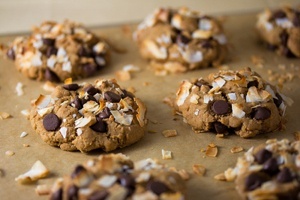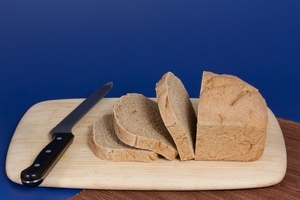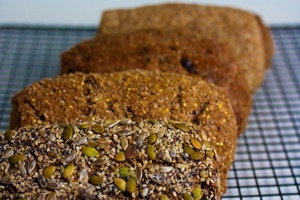Veganbaking.net
Vegan Baking Articles
Vegan Baking Guides
How to write a recipe that's easy to follow and fun to read
How to write a recipe that's easy to follow and fun to read
0
Comments (4)

The concept of reading words and numbers and using them to direct you to make something to eat is a strange thing. This simple list of directions is often the only companion you have in your quest to replicate what the original baker created. It's a good thing she meticulously listed all of the ingredients, their measures and thoroughly described all of the steps in an easy to follow manner. Or did she? If we were to go back in time a little over a hundred years or earlier, we would need a large heaping spoonful of luck for many of our recipes to turn out as they were intended. Luckily, recipe writing has evolved. Read on to find out how to write a recipe so it's interpreted in a clear, fun and informative way.
Find Easy recipes on Veganbaking.net
A Little History On Kitchen Measuring
Prior to 1896, if you wanted to make an apple pie, finding a recipe was not a problem. The hard part was when you started following the recipe and it directed you to use "butter the size of an egg" and "a half teacup of water" with "a dash" of salt to make your crust, followed by "a couple modest handfuls" of chopped apples to use in your filling. It would probably be beneficial at this point to just include some sort of good luck chant along with the recipe while you're at it. Bakers back then weren't even that lucky. If you took the best apple pie recipe on earth and translated it to this fashion, it's almost guaranteed to turn out subpar.A girl by the name of Fannie Farmer noticed this issue and in 1896 published The Boston Cooking-School Cook Book which introduced the concept of using standardized measuring spoons and cups, as well as level measurements (this book is available to check out in it's entirety at the above link). It's amazing that the information in it is still relevant today. The publishers didn't expect the book to sell many copies but sell it did. The book was then revised and is still in print today as the Fannie Farmer Cookbook.
This revolutionized baking in North America because for the first time bakers had a standardized method in which to accurately specify ingredients for recipes. Likely around the same time the rest of the world standardized on measuring by mass instead of volume. There are certain advantages and disadvantages to each which will be highlighted in a future article.
Measuring by volume the way that Fannie Farmer invented spread quickly to become the standard for baking in North America probably because it's extremely easy and fast to scoop your ingredients and measure them at the same time. This must have made baking considerably more fun and foolproof at the time.
Since then the art of the recipe has slowly evolved into what it is today. There are many different recipe writing styles that convey their information with varying levels of success.
Recipe Layout
There are many different ways to design recipes but I've found that recipes tend to work best when they contain the following sections in this order:
An introduction, a description of the ingredients listed along with their measures, recipe steps, serving information, storage information and yield.
Recipe Introduction
The first goal in designing a recipe is to get people to want to try it. Most people aren't into reading recipe books like novels so it's a good idea to use this opportunity to engage your reader. Designing recipes for yourself only? Write a fun, informative introduction anyway. You'll see the recipe years later and the intro will will help you remember what you liked about that recipe. When I first started writing recipes I had a really hard time trying to write introductions that were engaging and that would encourage the reader to read further. This is something that I'm always working on and trying to improve. You will notice your writing skills improve with the more recipe introductions you do.An introduction should introduce the recipes main ingredients, sometimes describe how they work together and inform the baker what the recipe is going to be like when and/or after it's baked. It's an ice breaker and a little sneak peek for what's to come. it's also a great idea to tell a story to help engage the reader on a personal level but this is extra credit. Here are some examples below:
Rich Coconut Frosting Introduction
"This is probably the best tasting frosting I will ever come up with. This is because it uses a triple threat of coconut in the form of coconut milk, coconut oil and shredded coconut. It's similar in flavor and texture to the frosting at BabyCakes bakery except with shredded coconut added. It uses soy milk powder (not to be confused with soy flour) to improve it's creaminess and a dash of vanilla to tie it all together. This recipe is a delicate balance due to coconut oil's tendency to melt above 76F (24C). This is the caveat of using coconut oil in a frosting. Due to this, it's highly recommended that nothing be substituted in this recipe if you want it to turn out properly. When using this frosting and other coconut oil based frostings, try to keep your cake in temperatures below coconut oil's melting point or you risk being in a little bit of a sugary mess if you know what I mean. The shredded coconut can be omitted if you're interested in experimenting a little and using this frosting recipe as a base for other flavored frosting recipes."Agave Maple Syrup Introduction
"One of the best parts of growing up was waking up to the aroma of Dad's legendary pancakes every Sunday. After gorging on them doused with maple syrup, the fam and I would go hiking on Mt Tam. Like clockwork, I'd eventually proceed to have an enormous mysterious energy crash that would reduce me into a quivering mess that Mom would call 'the shakes'. I later found out this was because the maple syrup I loved so much was causing my blood sugar to peak, then crash due to it's high glycemic index. Now I'm a lot more careful by making sure that I get some veggie sausages and go easy on the maple syrup. Agave syrup has a significantly lower glycemic index than maple syrup. Adding maple extract to it makes it a delicious maple syrup substitution. Check out our article on sweeteners and glycemic index to see how different sweeteners stack up. The simple recipe for this syrup is after the break."Recipe Ingredients
It's important to list ingredients in the order that they are used. If they're being used at the same time list them in the order of the largest quantity to the smallest. This will minimize the tendency of your baker to get 'lost' in the recipe. We all know how frustrating it is to make something according to a recipe and have it not turn out, only to then notice that you got lost in the recipe and left something out.Standardize on a method of displaying your measures. Fractions like 1/4 cup are much easier for people to interpret than decimals like .25 cup.
It's a good idea to spell teaspoon with a lowercase 't' and Tablespoon with an upper case 'T'. I can't count the number of times I've accidentally used a Tablespoon instead of a teaspoon of something because I glanced at the recipe quickly and Tablespoon was written with a lowercase 't' and I though it specified a teaspoon.
If your recipe's measure is slightly under a cup I've found that stating something like 3/4 cup + 2 Tablespoons is easier than stating 1 cup - 2 Tablespoons. If someone were to be working fast they could accidentally add 1 cup then realize that they added 2 Tablespoons too much.
Don't use redundant measures like 3 teaspoons or 4 Tablespoons. There are three teaspoons in a Tablespoon and 4 Tablespoons in a ¼ cup. Take advantage of the real-time Baking Unit Converter to simplify your measures. Instead of stating 7 teaspoons, state 2 Tablespoons + 1 teaspoon to make things as easy and convenient as possible.
When specifying things like chopped nuts it's usually easier to specify it in the ingredients list as 1 cup walnuts, chopped instead of going into detail in the recipe steps.
I've found that separating the ingredients by a space according to the recipe steps is a great way to help your bakers stay on track in the recipe. For example note how the ingredients are spaced according to the recipe steps for the Rich Vanilla Frosting below:
1 cup + 2 Tablespoons granulated white sugar
7 Tablespoons water
3 Tablespoons soy milk powder
½ teaspoon salt
1 cup vegetable shortening (2 sticks)
2 teaspoons vanilla extract
1 teaspoon apple cider vinegar
¼ teaspoon almond extract
1)
In a small saucepan whisk together the sugar, water, soy milk powder and salt over medium heat until the mixture boils. Continue whisking exactly 1 additional minute. This is so the sugar is dissolved and the starches in the soy milk powder are activated to a certain point. Remove from heat, transfer to a heat proof bowl and let it cool in the refrigerator until cold, about 1 hour or until it's near room temperature.
2)
Transfer the mixture to a food processor and add the shortening, vanilla extract, apple cider vinegar and almond extract. Process for 2 minutes. Scrape down the sides of the food processor and process for another 2 minutes. Processing will slightly heat up the frosting and may make it a little runny. Put the frosting in the refrigerator for about 30 minutes to quickly return it to room temperature if you're planning on using it soon. Once at room temperature, this frosting holds it's shape and can be frosted, piped or secretly eaten directly out of it's container.
Recipe Steps
As you saw above, recipe steps listed according to the order of the ingredients used allows the baker to proceed down both lists and rarely lose track of where they are. Another step to ensuring that bakers don't get off track while journeying down your recipe is to organize your instructions into numbered steps. These steps easily partition the recipe into several mini-recipes which makes it considerably easier to follow. The baker can literally walk away, return and jump right back into recipe if they know that they're at Step 2. Another advantage of using numbered recipe steps is that when the baker is first scanning the recipe, she can determine roughly how complicated the recipe is going to be to prepare by seeing how many steps are involved.Serving Information, Storage Information and Yield
Serving information is extremely important and is left out of may recipes unfortunately. Are the baked apples intended to be served warm? Cold? Room temperature? With a sauce on top? If so, what kind? What temperature is the sauce supposed to be? Eating a cold baked apple without anything on top surely wouldn't be something you'd remember for very long. I usually place serving instructions in the last recipe step. Sometimes it consists of the entire last step of a recipe if the serving happens to be more involved. After all, serving is still part of the baking process as a whole.Storage information is important because caring for the baked item is going to have a huge impact on how long it stays around and is enjoyed. If your poached pears in red wine are stored covered in the refrigerator they will probably be around to enjoy for a few days instead of just one day in a bowl on the counter. It's a good idea to place storage information at the end of the last recipe step.
How many cookies does this recipe make? Will I have to double the recipe or halve it? The bottom of a recipe is a good place to put things like yield information and storage instructions. Some people like to put yield information at the top of the recipe right under the introduction because that part of the recipe is looked at early on. I haven't found this to be a significant advantage; when I'm looking at a recipe to decide if I want to bake it I scan the whole thing anyway so I'm going to find the yield information no matter where it is. It might as well be tucked away at the bottom. That said, it doesn't really make a huge difference where your recipe yield is located, as long as it's there.
Following these guidelines when creating recipes will help future recipe readers (not to mention yourself after a few years of not making the dish) to recreate your masterpieces with as much ease and as much fun as possible. Have any tricks that you use in your recipe writing that you'd like to share? Let us know in the comments below.
For more information on recipe writing, check out the fantastic book The Recipe Writer's Handbook by Barbara Gibbs Ostmann and Jane L. Baker.
Recipe picture by calliope via Flickr






